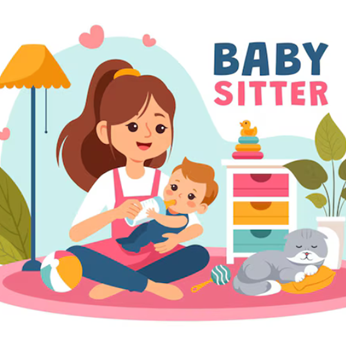How To Train Your Cat To Use The Litter Box
Cats are great pets and train themselves to use the litter box for their pee or poop; but most cats/kittens would not use a litter box that is dirty; keeping the litter box clean with several inches of litter in the box and changing it twice a week would help.
Ways to train your cat to use the litter box:
1) To ensure that the cats/kittens use the litter box make sure that it is cleaned daily; scoop out the solid and liquid waste at least twice daily and wash the entire box with soap and water at least once a week. Use unscented dish soap and warm water for the weekly cleanings and rinse the box well afterwards. In case of disease or worm infestation use a weak bleach solution after cleaning with soap and water.
2) Cats are picky and could refuse to use a changed litter box; change back to the old one. Besides a baking pan, a plastic container or a cut down cardboard box there are commercial litters also. Avoid the use of scented litters as cats/kittens do not prefer them. Make sure the litter box is big enough to allow the cats/kittens to move about freely and low enough for kittens to climb over. It is dangerous to use clay clumping litter for young kittens as it could cause intestinal blockages if accidentally ingested. Add some shredded shiny newspaper on top of their regular litter if your cat has just been declawed; it will cushion their sore paws and not stick to them.
3) The litter box and the cat should be placed in a small room as a bathroom; ensure they have enough food and water and check every hour or so. Praise the cat and give it a treat or some supervised playtime if it has eliminated correctly in the litter box. If the cat misses the box place the feces in the litter box and leave the room without paying further attention to the cat. Check after an hour repeating this procedure 2 to 3 times until you are sure the cat has been trained.

4) Ensure you place the litter tray in a quiet place away from noise; cats prefer privacy, so it is preferable to place it in a corner or with at least one wall behind it. Make sure you avoid placing the litter box close to food and water bowels. The cat should know where the litter box is so it can reach it easily; as a thumb rule it is best to provide at least one litter box for each cat and place it in multiple locations if the house is large.
5) Take your pet cat to a vet if it has been avoiding to use the litter box; it could be due to medical conditions like urinary infections, kidney problems or parasites. This behavior could also be due to certain changes in its routine, adding of another person or pet to the household or changing the location of the litter box to a new location where there are noise or light changes; these changes could stress your cat. You could overcome this by consulting a vet for a check-up and taking his suggestions that would help the cat.
6) Last, but most important be patient while training your cat to use the litter box; he may not get it the first time. Never punish the cat if it makes a mistake; it could stress the cat and he may not cooperate.
Image Courtesy: Google
Take the next step toward your goals
Share your requirement and find the best care providers in your area
-
Looking for a caretaker’s job? Build your profile and get in touch with families in your vicinity.
-
Discover nannies, babysitters, cooks, housekeepers, pet sitters, and elder care under one roof.
-
Get all the support you need to run a successful care center.
-
Search for appropriate centers near you depending on your needs.
Care Corner Insights: Blog Library

Nanny vs. Daycare in Naperville, IL: What Works Best for Indian Working Couples?
Hey Naperville Parents! Balancing work and family life is no small feat—especially for Indian working couples trying to juggle careers, household responsibilities, and parenting. One of the biggest decisions you’ll face? Choosing between a nanny or

Housekeepers in Sugar Land, TX: Deep-Cleaning Checklists for Indian Homes
Housekeepers in Sugar Land, TX: Deep-Cleaning Checklists for Indian Homes Indian cooking = flavor + spices + love… but also oil splatters and stubborn stains. Time to reset! Degrease stovetops, chimneys, and exhaust fans. Scrub countertops, tiles,

12 Easy After-School Snack Ideas for Kids Who Get Hungry Quickly
School’s out, and the hunger hits hard! If your little ones come home ravenous and ready to raid the kitchen, you’re not alone. After-school snack time is prime time for refueling, recharging, and maybe even sneaking in a little nutrition. So here ar

Vegetarian Home Cook Services in Sunnyvale, CA: North & South Indian Meal Prep for Busy NRIs
Between work, family, and daily responsibilities, finding time to cook fresh meals can be difficult. That’s when a vegetarian home cook service in Sunnyvale makes life easier—bringing authentic North and South Indian dishes straight to your table. T

Hiring a Live-In Nanny in Plano, TX: A Practical Guide for NRI Households
For NRI families living in Plano, TX, raising children while managing work and household responsibilities can feel overwhelming. Many parents find that hiring a live-in nanny provides the right balance of support, convenience, and cultural comfort. U

Daycares in Fremont, CA for Indian Toddlers: Curriculum, Food Policies & Waitlists
You’ve probably met them — the parents at the park chatting about Montessori vs. play-based learning while handing their toddler a homemade paratha. The ones who ask every daycare in Fremont if they serve vegetarian meals. And yes, the ones who have

Babysitters in Jersey City, NJ for NRI Parents: Last-Minute, Weekend & Evening Options
You’ve probably seen them — the parents juggling grocery bags in one hand and a phone call to grandma in India in the other, while trying to keep their toddler from running into the road. The ones who cancel dinner plans because the babysitter bailed

Best Nanny Services in Edison, NJ for Indian Families: Costs, Language, and Cultural Fit
Edison, NJ, is home to one of the largest Indian communities in the U.S., and finding a nanny here often means looking for more than just childcare skills. For Indian families, cultural understanding, language fluency, and traditional values play a b

What Is Helicopter Parenting? How It Affects Children and Ways to Avoid It
You’ve probably seen them. The parents at the playground who shadow every move, wiping invisible germs off the slide before their child touches it. The ones who fill out job applications for their teens. And yes, the ones who email college professors

Are Weighted Blankets Safe for Children? Pros and Cons Explained
Weighted blankets have become a cozy trend in recent years. From helping adults sleep better to calming anxiety, they’ve earned a spot in many households. But when it comes to kids, especially the little ones, parents often ask: Are weighted blankets